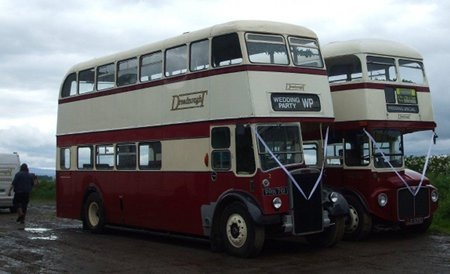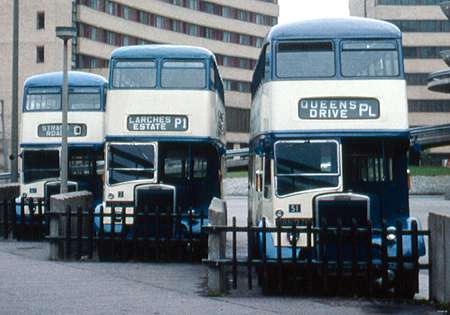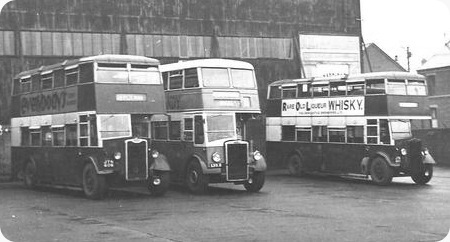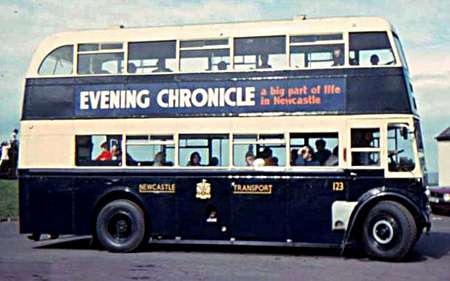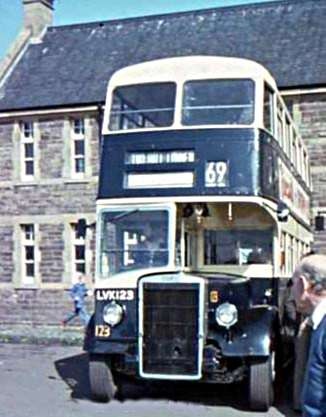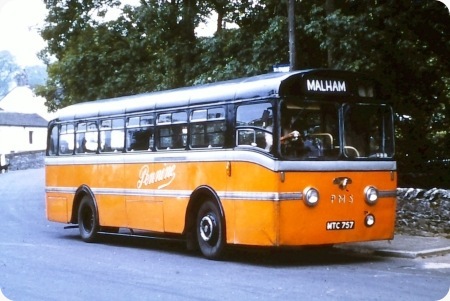
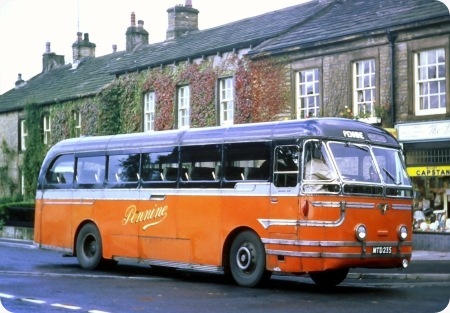
Both photographs by ‘unknown’ if you took this photo please go to the copyright page.
| Pennine Motor Services |
|
| MTC 757 |
MTD 235 |
| 1950 |
1952 |
| Leyland Royal Tiger PSU1/13 |
Leyland Royal Tiger PSU1/15 |
| Brush B44F |
Leyland C41C |
There has been some discussion on another posting about the former Leyland demonstrators, MTC 757 and MTD 235, the latter being still with Pennine and mentioned in the new PSV Circle listing on preserved buses. I have "bought" slides of these two, and I know when and where they were taken, but I’ve no idea of the photographers. MTC 757, the bus version, is seen in Malham in June 1964. MTD 235 is seen in Gargrave in September 1967. MTC 757 had a Brush bus body, while MTD 235 is quite clearly Leyland’s own. ‘The Dalesman Cafe’ on the right of the lower shot was still thriving when I was last in Gargrave a few months ago!
Photograph and Copy contributed by Pete Davies
05/08/12 – 12:31
Wouldn’t you put the dates of these two the other way round? The bus looks remarkably modern and simple for 1950- even the peaked front dome (or is that a trick of the light?) Could it be a rebuild? On the other hand the Leyland (export?) body looks a bit 1940’s Detroit at the front, especially that chrome "dribble".
Joe
05/08/12 – 14:11
Joe, it’s definitely a trick of the light – MTC 757 did not have a peaked dome, and was a very neat looking bus for the time. It was built in 1950, and acquired by Pennine in 1951. They withdrew it in 1967 and it is believed to have been scrapped.
MTD 235 was the prototype for the Leyland Royal Tiger coach body, and as originally built it did not have the multi-windowed ‘lantern’ type windscreen arrangement seen here and familiar on all the production examples, though it must have been modified very early on, as all the photos I’ve seen of it with Pennine show it as it is here. I must rack my brain (quite difficult nowadays) and try to remember which book I have that shows it in its original form and report back. Don’t hold your breath !
John Stringer
05/08/12 – 14:34
I had – please note the past tense! – black and whites of both these vehicles, and taken at Lancaster Bus Station. MTC most certainly did not have a peaked front dome. I have a copy of the Pennine history by Donald Binns in collaboration with the operator, which has a photo of her on page 49. The caption includes "It was scrapped in August 1967 after 16 years service and with 825,000 miles on the clock".
Pete Davies
05/08/12 – 14:35
The dates given in the posting would seem to be correct. MTC 757 was a Royal Tiger PSU1/13 with Brush B44F body built as a demonstrator in 1950, and bought by Simpson of Gargrave t/a Pennine in 1952. Brush ceased building psv bodies in 1952. MTD 235 was also a Leyland demonstrator, and it carried the standard Leyland 41 seat coach body for this model, though the chrome trim was adapted to meet customer choice, and some examples did not have the "swept under" front panelwork. This body continued to be available up to the time that Leyland closed its coachbuilding facilities in 1954. The PSU1/13 version of the Royal Tiger had the horizontal O.600 engine coupled with a four speed synchromesh gearbox and vacuum brakes.
Roger Cox
05/08/12 – 15:06
MTD 235 is still owned by Pennine and is kept at Barnoldswick and is worked on when time permits.
Philip Carlton
06/08/12 – 07:27
The Brush body was a nice design and must have been one of the very earliest on an underfloor engined chassis (apart from BMMO). Quite different to those supplied to Yorkshire Traction/Woollen. Presumably it was 7ft 6in wide?
Chris Barker
06/08/12 – 08:34
Chris, MTC and MTD were both to the usual 8ft width for underfloor engined vehicles of the time, so far as I am aware.
Pete Davies
11/08/12 – 07:23
Think 8′ was standard width for these underfloors. Although they still existed quite recently as a heavy engineering and railway manufacturer, Brush effectively became Willowbrook in bus terms. [Not sure who bought whom.] The next Royal Tigers for Tracky were Willowbrook – but built by the same men in the same factory.
David Oldfield
11/08/12 – 12:07
Several Royal Tigers were built to 7ft 6in width, it was offered by Leyland as an option. Hebble and Devon General had some Willowbrook bodied examples.
Brush are still very much in business, in Loughborough adjacent to the railway station. It was just their bus building activities which they disposed of in 1952. All production was then transferred to Willowbrook including some double deck Daimlers for Derby which were in build at the time and Brush designs disappeared almost immediately.
Chris Barker
12/08/12 – 07:16
Willowbrook existed in Loughborough from 1931, totally independent of Brush. They occupied the retail site now known as Willowbrook Park.
Brush voluntarily quit the bus body building enterprise in 1952, but locals tell me that their designs were passed to Willowbrook.
As Chris says, Brush are still in business, but they are a mere shadow of what they once were, and are no longer the town`s biggest employer. Once upon a time, they were the second largest tramcar builder in the UK, and that was just part of their total business!
What about Pennine though! Still in business, and they have seen it all and survived it all, and still continue as a small independent. I remember them well from my courting days, with wife to be living past Settle, on the Pennine route!
Good old Happy Days are getting even happier!
John Whitaker
12/08/12 – 07:18
I thought Pennine only had a garage in Skipton, but from Philip’s comment above, and from looking at their current timetable showing some early morning services starting in Barnsoldswick, I realise they have a garage there as well. Does anyone know how many vehicles are accommodated there; presumably only 4 or 5?
Dave Towers
28/08/12 – 14:29
The Pennine garage at Barnoldswick was acquired with the business of Ezra Laycock Ltd in 1972. As an ex-Laycock employee I ought to be able to confidently tell you the depot’s capacity – I can’t quite do that, but I think that the answer is five, although in Laycock days vehicles were parked outside as well. According to the timetable three buses start and finish at Barnoldswick, so that is presumably how many operational buses are kept at the depot. I did have it in my head that MTD 235 had been moved to Skipton, but I may have imagined that bit.
As far as I am aware Pennine also continues to use the small depot at Settle, capacity two vehicles.
David Call
29/08/12 – 07:26
I notice that Pete Davies has mentioned (on the Pennine LWY 702 posting) that MTD 235 is indeed now resident at the Skipton depot.
David Call
29/08/12 – 18:59
All is explained, at last. The section about MTC 757 & MTD 235 appears under a total of four headings – Brush (bodybuilder), Leyland (bodybuilder), Pennine (operator), and Leyland Royal Tiger. Only under the heading of Leyland Royal Tiger is there a section devoted to Pennine’s LWY 702, and it is at the foot of that section where Pete Davies has mentioned that MTD 235 is now at Skipton depot.
I would not expect LWY 702 to be mentioned under Brush, of course, but I am surprised that it does not at least get a mention under Pennine (operator). As to whether it should appear under Leyland (bodybuilder) or even Leyland (chassis builder), I suppose you will have to draw a line somewhere regarding what gets included and what doesn’t, there were an awful lot of Leyland buses manufactured. In passing perhaps I could mention that I noticed that under the heading of Leyland Royal Tiger Cub, only one of the three sections actually relates to an example of that model. The other two refer to the infinitely more common Leyland Tiger Cub.
Should I trawl through the other headings checking for similar errors/anomalies? It would beat counting sheep, I suppose.
David Call
30/08/12 – 06:56
The comments engendered by entries to this Forum frequently range far and wide, often well beyond the strict confines of the original submission. We have all had at least one reprimand, not, be it noted, from our webmaster, for straying from the initial subject, but that is entirely within the spirit of this site. The wealth of interest, information and detail that emerges thereby is invaluable. I think that we should go on regarding ourselves as a bus enthusiasts’ equivalent of Dr. Johnson’s Literary Club, with free ranging discussion. Cross referencing every point made in the "comment" columns would be a nightmarish task. Let us just be very grateful for this splendid site.
Roger Cox
30/08/12 – 11:47
Agreed, Roger. It’s worth remembering, too, that, although not as good as cross-referencing, there is a search facility on the website which I’ve found useful a couple of times.
Chris Hebbron
31/08/12 – 07:24
I think most of us form a loose group of cyber friends with a common purpose. I think that overrides any jobsworth tendency to pedantry – and that comes from one of the world’s biggest pedants!
David Oldfield
31/08/12 – 07:25
Contrary to what I stated above, it seems that the section devoted to LWY702 actually appears under all the headings I mentioned – I hadn’t realised that many of the headings lead to multiple pages. It does not help, of course, that my search engine (google) only picks up words and phrases which are contained in the first of those multiple pages – not the second and subsequent.
David Call
11/05/14 – 11:14
On the Pennine (operator) pages, Chris Wright and Orla Nutting comment on the forthcoming closure of the company.
There has been some confusion about MTD 235. Some sources say she’s at Barnoldswick (spoken locally as Barlick) and some (including me, based on reports I’ve had) say she’s at Skipton. To a degree, both are right and both are wrong! On withdrawal, she spent MANY years gathering dust at Barnoldswick garage. About 2 years ago, she was moved to head office with a view to start of restoration. The inspection was duly undertaken and it was found to be [I quote] ‘a massive job’ which would divert too many staff hours, so she’s back at Barnoldswick, apparently with one of the Leopards new to Ezra Laycock.
I suspect that a number of readers will be concerned about the future of MTD maybe she should could go either to the Leyland Museum or to the one in St Helens if the family don’t keep her.
Pete Davies
12/05/14 – 08:37
The ex-Laycock Leyland Leopard reputedly stored at Barnoldswick depot can only be OWY 197K, since that was the only Leopard ever owned by Laycock’s.
An interesting point is that throughout the few months of its time with Laycock’s, and into Pennine ownership, it carried the incorrect registration OWY 179K.
David Call
13/05/14 – 06:34
Thank you, David, for your comments about the Leopard. In the Donald Binns book about Pennine, there are two photographs showing her with OWY 197K, but the listings in the book show both registrations! She is shown in the book as being stored at Ingleton, but that is clearly out of date if my information from company staff the other day is correct.
Pete Davies
23/05/14 – 07:51
Pete. I paid my respects to Pennine on the last day 16th may I Actually wrote to Maurice Simpson wishing him well for the future and how sad it was Pennine Motors was closing down. I suggested MTD 235 should be restored in memory of his father and the company and what his plans are for the vehicle.
Work was carried out on the brakes and other bits and pieces the chief engineer tells me, however she is to be towed back to Skipton in the coming weeks but what the future is it is not clear as yet.
Mark Mc Alister
25/05/14 – 10:33
Thanks, Mark, for your update.
Before I retired, I worked in the passenger transport team of Southampton City Council, dealing with the local operators over aspects of their services. The national concession scheme was just coming into use. My managers commented on several occasions that the regulations said that the level of reimbursement must be strictly neutral, in that the operator must be no better off and no worse off through taking part in the scheme.
The reports I have read in various places all suggest that North Yorkshire County Council have a different view.
Pete Davies
26/05/14 – 09:28
The point made by Pete Davies was first specified in the Ridley 1985 Transport Act when each local authority had the power to determine a concessionary fare scheme. This led to wide variations throughout the country, and some authorities, of course, chose not to offer any meaningful scheme at all, which was one of the reasons why the Labour government, in reality, John Prescott, decided to ensure that mandatory schemes were available everywhere from 2001. This was followed up in 2007 by a national scheme for England. The Welsh and Scottish administrations pursued their own policies. This new scheme maintained the requirement that "Travel Concession Authorities are required by law to reimburse bus operators for carrying concessionary passengers, on the principle that the operators are "no better off and no worse off" by taking part in concessionary travel schemes. The aim is not to subsidise bus operators, but to pay for any increased costs that they have incurred". The legislation goes on to say, "The national bus concession in England is available at any time on a Saturday, Sunday or bank holiday, and from 9.30am to 11pm on any other day. TCAs are able to offer concessionary travel outside these hours on a discretionary basis". I understand that North Yorkshire allows the passes to be used from 9am until 6am the following morning, which is entirely lawful under the clause stated above.
Roger Cox
26/05/14 – 09:29
The situation in respect of the depot premises is as follows.
Skipton: To let at £40,000 p.a. or might sell
Barnoldswick: Sale agreed
Ingleton: Sale agreed
Settle: For sale (‘Guide price’ £75,000) or might let
As Mark McA says, the future for MTD 235 is not clear – it looks even less clear now. We can only hope that it will be, as suggested by Pete, donated to one of the established museums.
David Call
26/05/14 – 14:01
Quite right, Roger, but it’s the amount of reimbursement that seems to have upset matters in this case.
Pete Davies
21/02/16 – 15:44
Re MTD 235 – can anybody give me an update on this coach’s current condition and location please?
Howard Piltz
21/03/16 – 15:54
It appears to have been offered for sale on Ebay in 2014 but the highest bid, just over £2K, didn’t meet the reserve price. Since then it has been off the radar.
Mike Morton
23/03/16 – 05:42
"Just over £2K", Mike? That’s just silly, given the nature of the beast. I’d have expected another ‘0’ on the figure . . .
Pete Davies
23/03/16 – 17:10
Pete
That’s the reality of Bus Preservation lots of effort/money but nothing like the financial return of vintage cars.
Roger Burdett
23/03/16 – 17:14
Sadly Pete, the generation of enthusiasts that remember and appreciate this era of classic vehicle are getting on in years and fewer in number, and probably feel that it is a bit late in the day to start getting involved in such a substantial and expensive restoration. The majority of active preservationists nowadays are more into the vehicles of their youth – such as Nationals, Olympians and Metrobuses, and even more recent types than those.
I attended the open day at the Dewsbury Bus Museum the other week and thought I’d sample a few rides on the free bus service into Dewsbury and back. I rode on the superb recently restored West Riding PD2 and then the West Riding PS2 but was surprised to note that though plenty people were photographing them, there were relatively few that chose to ride on them, whereas the Olympians, RELL, Leopard and even the virtually new Arriva Enviro Whateveritis were packed out with excited punters.
Time moves on, and so will we, and I fear for the long term future of many of our favourite classic buses.
John Stringer
24/03/16 – 05:56
Re MTD 235. It did not meet reserve on eBay in 2014 (highest bid £2250) so presumably its still with Simpson (t/s Pennine Coaches) Skipton.
John Wakefield
24/05/16 – 08:58
MTD 235 once again on Ebay.
Dave Philpot
30/05/17 – 06:42
MTD 235 has been sold on in Yorkshire.
Phil Clark
22/11/17 – 07:37
I can report that restoration of ex-Pennine Royal Tiger MTD 235 is continuing with the mechanics receiving a thorough overall and work commencing on the body. It is hoped that it will make a return to the road one day soon, keeping fingers crossed!
Phil Clark
23/11/17 – 07:09
Wonderful news!
Pete Davies
23/11/17 – 07:10
Good news indeed Phil-thanks for the report.
Stuart Emmett
23/09/18 – 06:14
I am currently restoring the ex-Pennine Leyland Royal Tiger MTD 235 – has anyone got a destination blind for this or any Pennine posters or notices or timetables that were displayed in their buses in the 1950s, 1960s or 1970s? I will be pleased of any help or copies of anything that will add to the restoration. Thank you, you can contact me through this website.
Phil Clark
05/11/18 – 13:38
The only blind I have seen also covers 1972, 1983 and 1986 changes and includes the former routes of Laycock, Skipton and the ex Ribble locals and Burnley etc.
1950’s’/1960’s when MTD was in main service then the range was small. Therefore would suggest only needs to include Malham, Tosside, Morecambe, Lancaster, Ingleton, Gargrave, Settle, Skipton, and Contract.
On further materials-assume, you already will have the Donald Binns 2000 book called Pennine Motor Services that includes many timetables.
Hope this helps and that your worthwhile project continues on. Any ideas when it might be completed?
Stuart Emmett
 Vehicle reminder shot for this posting
Vehicle reminder shot for this posting
18/11/18 – 09:26
I’m trying to locate the Leyland Royal Tiger MTD 235 mentioned in your website. My dad is a retired bus driver and it’s his favourite bus. I’m trying to arrange just to see it really.
Steven Davies
27/01/19 – 07:41
Thanks for your info on MTD 235 destination names that will be useful, at the moment it has no blind gear as this must have been removed some time ago, so I am trying to find replacement blind gear (if anyone has some!). I haven’t found that book on Pennine but I hope I’ll find it some day. I have found some old Pennine excursion flyers which I hope to make use of. Restoration continues albeit slowly as I’m finding much of the rear end wood frame has decayed or is missing and this is not my favourite job! I am part way through rewiring the coach as much of the original is in a very poor state. I think it will be a while yet before it is finished, but if anyone has any memorabilia, old Pennine notices, posters or unpublished photographs I will be pleased to know!
Phillip Clark
28/01/19 – 07:39
Pennine book available right now suggest be quick www.abebooks.co.uk/
Stuart Emmett
29/07/22 – 05:56
Hello Phillip – wondering how the preservation of MTD 235 is progressing please.
Stuart Emmett
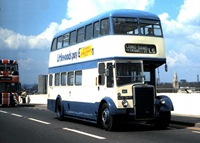 Vehicle reminder shot for this posting
Vehicle reminder shot for this posting 
